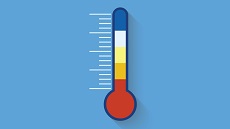
Maintaining the temperature while goods are being transported is essential for many different products. Of course, you will instantly think of fresh meats and dairy products. However, frozen items also need to be kept at the right temperature, as do sensitive electronics.
The problem for manufacturers is that they can’t control the temperature of the shipping environment once it leaves the factory. They are reliant on the supplier having the appropriate systems to maintain and monitor the temperature within the lorry and ensure the goods arrive in perfect condition. As a manufacturer or supplier, you can vouch for the product up until it leaves your factory. From the moment it goes into the transportation hands you need to be happy that they have the right temperature and it is maintained.
How Temperature Monitoring Works
Temperature monitoring involves having a sensor inside the truck. This verifies the current temperature and will automatically tell the cooling system if the temperature is rising. In effect, it works like a thermostat. As soon as the temperature starts to rise cooling air is pumped into the area to ensure the temperature remains in the correct range.
But, if the sensor dictates that the temperature is continuing to rise, it suggests an issue with the cooling system. The sensor will be set to create an alarm. This alarm can be sounded in the cab and head office may also be alerted, allowing them to dispatch a spare truck to help with maintaining the temperature of the product, if necessary.
Alongside this, the sensor will create a log of the temperatures throughout the journey. This log can be accessed by the shipper to confirm the temperature parameters have remained correct. It is worth noting that some systems simply record this information while others will dispatch it wirelessly to head office while you are driving.
Extra Precautions
Manufacturers and suppliers who wish to be certain that everything has been recorded properly can invest in a temperature data logger. These are stickers that can be adhered to specific parcels or pallets of goods. The sensor has a dot in the center which will change color if the temperature moves outside of the given range.
The great thing about these is that they can be placed n specific packages and checked by the receiver, without needing to look at the transportation record. It inspires confidence in the transportation process.
It should be noted that data loggers aren’t just there for monitoring temperature. They can also be used to monitor shocks and humidity. This can be very important for some products, even more than the temperature range.
Insurance Costs
As a bonus, using a temperature logger will often reduce the price of the business insurance. This is because it is easier for the insurer to allocate blame and ensure the correct party pays for the damage. It also reduces the likelihood of this happening as people are more aware of the issues.






